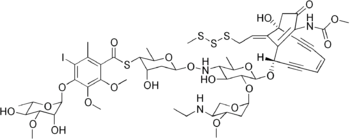Calicheamicin
| Calicheamicin k | |
|---|---|
 | |
| Identifiers | |
| CAS number | 108212-75-5 |
| ChemSpider | 27330302 |
| Jmol-3D images | {{#if:CCN[C@H]1CO[C@H](C[C@@H]1OC)O[C@@H]2[C@H]([C@@H]([C@H](O[C@H]2O[C@H]3C#C/C=C\C#C[C@]\4(CC(=O)C(=C3/C4=C\CSSSC)NC(=O)OC)O)C)NO[C@H]5C[C@@H]([C@@H]([C@H](O5)C)SC(=O)c6c(c(c(c(c6OC)OC)O[C@H]7[C@@H]([C@@H]([C@H]([C@@H](O7)C)O)OC)O)I)C)O)O|Image 1 |
| |
| |
| Properties | |
| Molecular formula | C55H74IN3O21S4 |
| Molar mass | 1,368.35 g mol−1 |
| Except where noted otherwise, data are given for materials in their standard state (at 25 °C (77 °F), 100 kPa) | |
| Infobox references | |
The calicheamicins are a class of enediyne antibiotics derived from the bacterium Micromonospora echinospora, with calicheamicin γ1 being the most notable.[1] It was isolated originally in the mid-1980s from the chalky soil, or "calichi pits", located in Kerrville, Texas. The sample was collected by a scientist working for Lederle Labs.[2] It is extremely toxic to all cells and in the year 2000, a CD33 antigen-targeted immunoconjugate N-acetyl dimethyl hydrazide calichiamicin was developed and marketed as targeted therapy against the non-solid tumor cancer acute myeloid leukemia (AML).[3] Calicheamicin γ1 and the related enediyne esperamicin are the two of the most potent antitumor agents known.[4]
Mechanism of toxicity
Calicheamicins target DNA, causing strand scission. Calicheamicins bind with DNA in the minor groove, where they then undergo a reaction analogous to the Bergman cyclization, generating a diradical species. Like all enediynes, this diradical, 1,4-didehydrobenzene, then abstracts hydrogen atoms from the deoxyribose (sugar) backbone of DNA, which results in strand scission.[5]
Biosynthesis
The core metabolic pathway for biosynthesis of this molecule resembles that of other characterized enediyne compounds and occurs via a polyketide synthase pathway.[6] The specificity of binding of calicheamicin to the minor groove of DNA was demonstrated by Crothers et al. (1999) to be due to the aryltetrasaccharide group of the molecule.[7][8]
History
It has been proposed that Alexander the Great was poisoned by drinking the water of the river Styx (Mavroneri) which happened to be contaminated by this compound.[9][10]
See also
- Monoclonal antibodies using calicheamicins as cytotoxic agents:
References
- ↑ Lee, May D.; Manning, Joann K.; Williams, David R.; Kuck, Nydia A.; Testa, Raymond T.; Borders, Donald B. (July 1989). "Calichemicins, a novel family of antitumor antibiotics. 3. Isolation, purification and characterization of calichemicins β1Br, γ1Br, α2I, α3I, β1I, γ1I, and Δ1I". Journal of Antibiotics 42 (7): 1070–87. PMID 2753814.
- ↑ Total Synthesis and the Creative Process: An Interview with K.C. Nicolaou, Scripps Research Institute
- ↑ G.A. Ellestad (2011). "Structural and Conformational Features Relevant to the Anti-Tumor Activity of Calichemicin γ1I". Chirality 23: 660–671.
- ↑ Calicheamicin and Esperamicin are the two most potent antitumor agents known to man, Univ Of Georgia, Chem 4500
- ↑ S. Walker; R. Landovitz; W.D. Ding; G.A. Ellestad; D. Kahne (1992). "Cleavage behavior of calicheamicin gamma 1 and calicheamicin T". Proc Natl Acad Sci U.S.A. 89 (10): 4608–12. doi:10.1073/pnas.89.10.4608. PMC 49132. PMID 1584797.
- ↑ Horsman, GP; Chen, Y; Thorson, JS; Shen, B (Jun 22, 2010). "Polyketide synthase chemistry does not direct biosynthetic divergence between 9- and 10-membered enediynes". Proc Natl Acad Sci U S A. 107 (25): 11331–5. doi:10.1073/pnas.1003442107. PMC 2895059. PMID 20534556.
- ↑ Simkhada D, Oh TJ, Kim EM, Yoo JC, Sohng JK (January 2009). "Cloning and characterization of CalS7 from Micromonospora echinospora sp. calichensis as a glucose-1-phosphate nucleotidyltransferase". Biotechnol Lett. 31 (1): 147–53. doi:10.1007/s10529-008-9844-9. PMID 18807197.
- ↑ Zhang C, Bitto E, Goff RD, Singh S, Bingman CA, Griffith BR, Albermann C, Phillips GN Jr, Thorson JS (Aug 25, 2008). "Biochemical and structural insights of the early glycosylation steps in calicheamicin biosynthesis". Chem Biol. 15 (8): 842–53. doi:10.1016/j.chembiol.2008.06.011. PMC 2965851. PMID 18721755.
- ↑ Nick Squires (August 4, 2010). "Alexander the Great poisoned by the River Styx.html". Telegraph.
- ↑ Rossella Lorenzi (16 Jul 2010). "Alexander the Great killed by toxic bacteria". Discovery News.